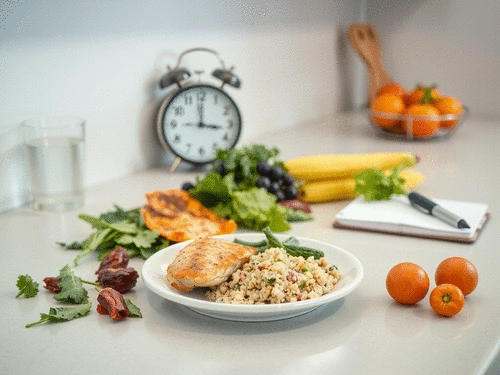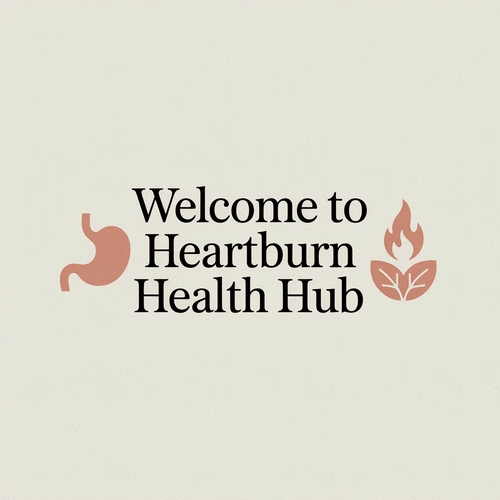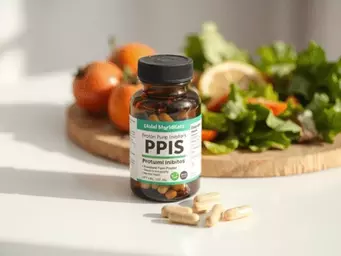Did you know that the way you eat can significantly influence your digestive health? Understanding heartburn and its triggers can empower you to manage this common condition effectively. Let's explore the crucial lessons that can help you regain control over your comfort and health!
What You Will Learn
- Heartburn is primarily caused by acid reflux, where stomach acid backs up into the esophagus.
- Identifying common food triggers like fatty foods, spicy dishes, and citrus can help manage symptoms.
- Eating habits—such as portion size and meal pacing—greatly affect stomach acid production and reflux likelihood.
- A food diary can be an effective tool for tracking triggers and managing heartburn symptoms.
- Creating a 7-day meal plan centered on fiber-rich foods can help alleviate heartburn discomfort.
- Engaging with healthcare professionals for personalized dietary advice is essential for effective heartburn management.
Heartburn Triggers & Management: A Visual Guide
Understanding what causes heartburn and how to prevent it involves recognizing common food triggers and adopting healthier eating habits. The visual below highlights key aspects of heartburn management, from problematic foods to effective prevention strategies.
Common Heartburn Food Triggers
- •Fatty & Fried Foods
- •Spicy Foods
- •Chocolate & Caffeine
- •Citrus Fruits & Juices
*These can relax the lower esophageal sphincter, allowing acid reflux.
Eating Habits Impacting Reflux
- •Eating Quickly (swallowing air)
- •Large Portions (stomach pressure)
- •Skipping Meals (leading to overeating)
- •Late-Night Eating (acid production)
*Mindful eating minimizes discomfort and improves digestion.
Benefits of Fiber-Rich Foods
- •Whole Grains (brown rice, quinoa)
- •Fruits (bananas, apples, berries)
- •Vegetables (spinach, sweet potatoes)
- •Legumes (lentils, beans, chickpeas)
*Fiber aids digestion and can reduce acid reflux symptoms.
Heartburn Management Strategies
- •Utilize Food Diaries/Apps
- •Consult Healthcare Professionals
- •Seek Nutritionist Advice
- •Plan Meals (7-day outline)
*Personalized approach key for effective management.
Understanding the Connection Between Eating Habits and Heartburn
Heartburn can often feel like an unwelcome guest at dinner, right? Understanding its connection to our eating habits is crucial for managing those pesky symptoms. At Heartburn Health Hub, I want to guide you through the role of acid reflux and how our choices can make a significant difference in our digestive health!
So, what causes heartburn, and how is it linked to acid reflux? When stomach acid flows back into the esophagus, it can create that burning sensation we're all too familiar with. This reflux happens when the lower esophageal sphincter weakens, allowing acid to escape. Knowing this is key to addressing how we eat and what we eat.
What Causes Heartburn? The Role of Acid Reflux
Heartburn is primarily a symptom of acid reflux, where stomach contents, including acid, flow back into the esophagus. This condition can be triggered by several factors, and it's essential to identify them to manage your symptoms effectively. For example, specific foods can relax that sphincter, paving the way for discomfort. According to research published in NCBI, identifying common food triggers is a vital step in managing heartburn.
- Fatty and fried foods
- Spicy foods
- Chocolate and caffeine
- Citrus fruits and juices
Keeping track of what exacerbates your condition can help you avoid these triggers. A food diary is a simple yet effective tool to discover patterns in your eating habits!

The Impact of Eating Habits on Stomach Acid and Reflux Symptoms
Did you know that how we eat can affect stomach acid production? Eating large meals can increase stomach pressure, leading to higher chances of reflux. My experience as a gastroenterologist has shown me that even the pace of eating can play a role in our digestive health! The way we eat, including meal timing and portion sizes, significantly impacts acid reflux symptoms, as highlighted in a recent study.
- Eating quickly often results in swallowing air, which can lead to bloating and discomfort.
- Large portions can stretch the stomach, causing excessive pressure on the sphincter.
- Skipping meals may lead to overeating later, triggering heartburn.
By being mindful of these habits, we can take proactive steps to minimize heartburn and improve our overall digestive well-being!
Gastroesophageal Reflux Disease (GERD): Understanding the Condition
Now, let's talk about GERD, a more chronic form of acid reflux. If you experience heartburn more than twice a week, you may be dealing with GERD. It’s not just annoying; it can lead to complications if left unmanaged.
- Inflammation of the esophagus (esophagitis)
- Strictures that narrow the esophagus
- Barrett's esophagus, which can increase cancer risk
Understanding GERD is essential for managing heartburn effectively. With the right information and strategies, we can tackle these issues together!
We Want to Hear From You!
What has been your biggest challenge in managing heartburn symptoms? Share your thoughts below:
Practical Tips for Heartburn Prevention Through Eating Habits
Managing heartburn effectively starts with making smart choices about what and how you eat. At Heartburn Health Hub, we believe that practical strategies can empower you to take control of your heartburn. Here are some actionable tips that will help you create a heartburn-friendly lifestyle!
Creating a 7-Day Meal Plan for Heartburn Management
Planning your meals can be a game-changer in managing heartburn. A well-structured meal plan not only helps avoid trigger foods but also ensures you eat balanced meals throughout the week. Here’s a simple outline to get you started:
- **Day 1:** Grilled chicken with steamed broccoli and brown rice
- **Day 2:** Oatmeal with sliced bananas and almonds
- **Day 3:** Quinoa salad with cucumbers, tomatoes, and lemon dressing
- **Day 4:** Baked salmon with asparagus and sweet potatoes
- **Day 5:** Turkey and avocado wrap on whole-grain tortilla
- **Day 6:** Stir-fried vegetables with tofu and brown rice
- **Day 7:** Lentil soup with a side of whole-grain bread
This seven-day meal plan includes a variety of fiber-rich foods and lean proteins, which are beneficial for your digestive health. Feel free to mix and match based on your preferences, but keep an eye on portion sizes!

Meal Prep Strategies for Busy Lifestyles
We all lead busy lives, and finding time to prepare healthy meals can be daunting. Here are some practical meal prep strategies to simplify your cooking while keeping heartburn in check:
- **Batch cooking:** Prepare larger quantities of meals to divide into portions for the week.
- **Pre-chop vegetables:** Spend a little time chopping vegetables for salads or stir-fries to save time during the week.
- **Use freezer-friendly containers:** Store meals in individual portions for easy reheating.
- **Plan snacks:** Keep heartburn-friendly snacks on hand, like yogurt or nuts, to avoid last-minute unhealthy choices.
Remember, by planning your meals and snacks ahead of time, you can reduce the chances of reaching for trigger foods when you’re hungry!
Incorporating Fiber-Rich Foods into Your Diet for Better Gut Health
Fiber plays a crucial role in digestive health and can help alleviate heartburn symptoms. Foods rich in fiber aid in maintaining a healthy digestive system and can reduce acid reflux. Here are some fiber-rich foods you should consider including in your diet:
- **Whole grains:** Brown rice, quinoa, and whole-grain bread
- **Fruits:** Bananas, apples, and berries
- **Vegetables:** Spinach, carrots, and sweet potatoes
- **Legumes:** Lentils, beans, and chickpeas
Integrating these fiber-rich options into your daily meals can not only help manage your heartburn but also contribute to overall gut health. So, why not start today? Your digestive system will thank you!
Taking Control of Heartburn: Next Steps for You
Now that we’ve covered some practical tips for heartburn prevention through your eating habits, let's discuss how you can take the next steps toward effective management.
Using Tools and Resources to Personalize Your Approach
Personalization is key when tackling heartburn. Utilize tools like food diaries or mobile apps to track your meals and symptoms. This will help you identify specific triggers and patterns in your eating habits. At Heartburn Health Hub, we’re here to support you with resources that guide you in making informed choices.
Engaging with Healthcare Professionals for Tailored Advice
Consulting with healthcare professionals, such as a gastroenterologist or a registered dietitian, can provide invaluable insight into managing your heartburn. They can offer personalized advice based on your unique health profile and dietary needs. Don't hesitate to reach out to them for guidance! For effective management, individualized dietary management is often recommended for GERD, as highlighted by Gastroenterology Advisor.
Nutritionist Recommendations for Managing Heartburn Effectively
In addition to working with healthcare professionals, consider seeking advice from nutritionists who specialize in digestive health. They can help you develop a tailored dietary plan that focuses on both preventing heartburn and promoting overall wellness.
Taking control of your heartburn requires commitment and proactive steps. By implementing these strategies and utilizing professional advice, you're well on your way to a happier, healthier digestive experience!
Frequently Asked Questions About Heartburn and Diet
- Q: What is the main cause of heartburn?
- A: Heartburn is primarily caused by acid reflux, which occurs when stomach acid flows back into the esophagus.
- Q: What common foods should I avoid if I suffer from heartburn?
- A: Common food triggers include fatty and fried foods, spicy dishes, chocolate, caffeine, and citrus fruits and juices.
- Q: How do my eating habits impact heartburn?
- A: Eating habits such as large portion sizes, eating too quickly, and late-night meals can increase stomach pressure and acid production, leading to reflux.
- Q: What is GERD, and how is it related to heartburn?
- A: GERD (Gastroesophageal Reflux Disease) is a more chronic form of acid reflux, characterized by heartburn occurring more than twice a week. If left untreated, it can lead to complications.
- Q: What types of foods are recommended to help manage heartburn?
- A: Incorporating fiber-rich foods like whole grains (brown rice, quinoa), fruits (bananas, apples), vegetables (spinach, sweet potatoes), and legumes (lentils, beans) can help alleviate symptoms and improve gut health.
Recap of Key Points
Here is a quick recap of the important points discussed in the article:
- Heartburn is primarily caused by acid reflux, where stomach acid flows back into the esophagus.
- Identifying and avoiding trigger foods like fatty, spicy, and citrus foods can help manage symptoms.
- Eating habits, such as portion sizes and eating pace, significantly affect stomach acid production and reflux symptoms.
- Planning meals and incorporating fiber-rich foods can improve digestive health and reduce heartburn occurrences.
- Engaging with healthcare professionals for personalized advice is crucial for effective heartburn management.









